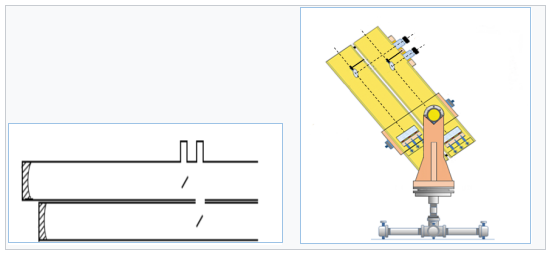We have a regular contributor to this website who is an expert in all thing binocular telescope. He is one of the world's foremost experts on them (Norm Butler) And he let me know about this unique and fun binoscope design.
There is almost nothing about it on the internet but what I can glean is that it was first proposed by M. Vallack in 1848 and it was described in Herschels book "The telescope" in 1861.
It is a pair of newtonian telescopes set up in a way that the light paths come to a pair of eyepieces at eye width. And the second scope light path passes through the tube of the first telescope.
See the attached original illustration as it appeared in " The Telescope " published by John Herschel in 1861.
"A twin Newtonian was proposed by M. Vallack, and described by John Herschel in The Telescope , published in 1861. Vallack wished to view by reflecting one light path over the open end of the other tube. Herschel devotes 7 pages to the binocular telescope, noting that it has been used for viewing the sun, moon, and planets;
"though without any very great practical advantage". >
If you have any more information about this design be sure to send me an email!
![]()
This pair of illustrations are modern and credited by the illustrator below.

https://commons.wikimedia.org/wiki/User:Namronpb
This file is licensed under the Creative Commons Attribution-Share Alike 4.0 International license.
Norm is digging up some great research for us:
Just follow uto up with a couple points that were stated in the Otto von Struve 1848 article about M. Vallack's proposed Newtonian binocular telescope...
Here is the original 1848 abstract that M. Otto von Struve published in " Monthly Notices of the Royal Astronomical Society, Volume 8, Issue 5, March 1848, Page 139 "....Trying to read it and understand everything that is said about M.Vallack's proposed Newtonian bino concept makes for an interesting and challenging read in itself....ha >https://doi.org/10.1093/mnras/8.5.139
the following sentence stated: "Mr. Vallack suggests the utility of adopting the binocular construction in astronomical telescopes, and especially in Newtonian reflectors. He has himself fitted up two mirrors on this principle, and finds considerable superiority in the pair over a single mirror".
However said...so far to date...there has been "no" drawing or illustration found that detailed the dimensions (primary/secondary mirror/prism diameters/focal ratios/focal lengths and tube lengths/tube diameters...etc.) of such a Newtonian binocular arrangement aside from a " single" concept drawing in a letter to Captain Smyth that was " void" of dimensional details that would support his claim that suggested he actually built such a Newtonian binocular arrangement. If he had made such an interesting Newtonian binocular telescope...it's obvious he would have probably made an effort to detail it's construction...at least for his own personal records and even perhaps historical and scientific purposes too.
Not much was written about the 1861 M. Vallack Binocular Telescope. Here's about all one will find about it no matter where you'll look. See the attached original illustration as it appeared in " The Telescope " published by John Herschel in 1861.
"A twin Newtonian was proposed by M. Vallack, and described by John Herschel in The Telescope , published in 1861. Vallack wished to view by reflecting one light path over the open end of the other tube. Herschel devotes 7 pages to the binocular telescope, noting that it has been used for viewing the sun, moon, and planets;
"though without any very great practical advantage". > http://home.europa.com/~telscope/binohist.txt
Someone has made one. And it was entered in the 2018 Stellafane competition. YOu can see it on this page here. Scroll down. It is seven up from the bottom. It was built by Peter Wraight. And, you can click on the thumbnails to get a bigger image. Right here
Dual Newtonian Offset Stacked Binoscope -
There is a man who has built one of these telescopes using predominantly 3d printed parts. It is a complete and working telescope! Wow! Take a look on his website here: Making Telescopes for astronomy using a 3d printer




